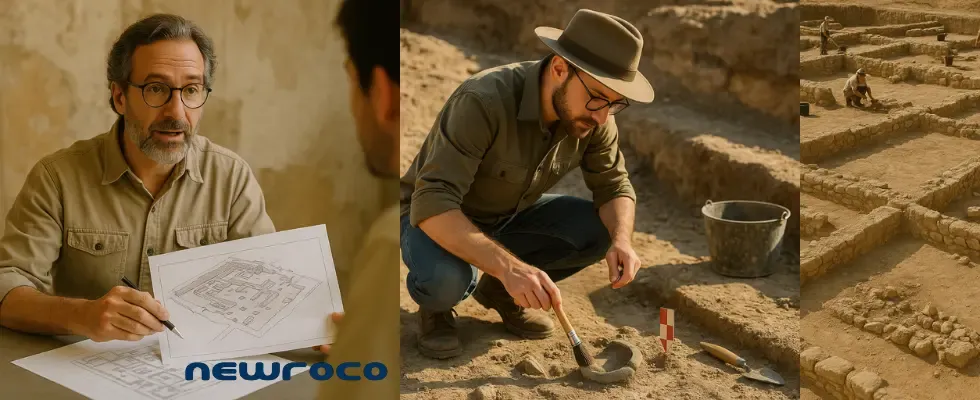
Archaeology is a complex discipline emphasizing detail, data accuracy, and solid collaboration. As more discoveries occupy archaeologists' time and attention, fieldwork evolves, demanding new tools to cope with the growing datasets.
They are complex and have many particularities. From artifact descriptions to stratigraphy layers, archaeological data needs more than the traditional pen and paper. The time of spreadsheets and binders is long gone.
Smart data management for archaeology is mandatory for the success and efficiency of all projects on site. Modern archaeology needs solid, intuitive, and efficient tools to support archaeologists on site and in the research lab. Collaboration is also important. Field documentation, data organization, sharing, and long-term preservation need upgrades to improve efficiency on and off-site.
Archaeologists work with thousands of items on a dig site. It can be overwhelming to register, label, note particularities, and share data with collaborators of fellow researchers. This is where personalized web apps come into play.
Benefits of using web apps for data management
Web apps are the perfect tools for archaeology. In today’s complex environment, digital transformation is mandatory. Without the right apps, things become stingy, hard, and complex. When you transition from pen and paper to digital tools, work becomes lighter and lighter. The benefits are immense, especially if you have personalized apps that precisely match your needs.
We are one of the few companies in Europe specialized in web apps for archaeology, with over 15 years of experience. We offer future-proof solutions that manage different data sets generated during archaeological digs and research.
1. Personalized content management systems (CMS): flexible structures
In our experience, a good CMS is important for archaeologists. We created HubAdmin , developed for a special client, Oxford Archaeology, a CMS personalized around the needs of some of the best in the field. With this CMS, archaeologists have the liberty of:
1. Organizing and storing their publication and grey literature without effort, with access to custom fields and templates, optimal for publication type-specific inputs;
2. Sharing publicly their data, or restricting access to collaborators to view specific content within permission roles when the data is not yet public;
3. Editing and retrieving content easily in various search methods, including on a map through a clean and user-friendly interface;
2. Field recording needs to go digital: Digital Recording System
Indiana Jones is great and all, but not efficient at all. Losing pen and paper opens the gates of missed opportunities. This traditional way of recording data has lost its charm. Digital recording yields efficiency and accuracy during work. So, where to start?
Better site documentation: archaeologists register artifact types, stratigraphic layers, soil description, and, with only a few clicks, more often in real-time during fieldwork. Researchers obtain data and start working on new theories with no delays.
Structured data via predefined templates and controlled vocabularies standardizes entries. This particular process reduces errors and enhances search patterns in the future.
Export capabilities are perfect for locking in records, backing them up, and also archiving them following specific institutional protocols and regulatory standards.
Our active solutions support workflow from the early stages of an archaeological project to the dedicated work in research laboratories. Archaeologists looking to digitize their operations should look into Newroco's web development capabilities.
3. GIS integration: see the past in real-time
GIS is very important to the work of any archaeologist, beginner or highly experienced. Maps are an essential part of reconstructing the past. Once integrated in a centralized data platform, GIS offers context to finds on site.
We offer solutions that can help you:
- Drag and drop GIS data directly into the system. No fuss, no wasted time. You can opt to insert data like field maps, trench layouts, excavation boundaries, and structures, with overlays over satellite images and historical cartography.
- Manage with greater ease layers, being able to differentiate between different excavation phases, burial zones, and distinct environmental particularities.
- Tight and interactive collaborations. Users can add pins, annotations, and new data layers in real-time. Team members can plan better and perform post-examination analysis with the correct data.
- Visual representations in any historical analysis are important. It adds depth to findings in studies, academic and public presentations. Our GIS-mapping tools are easy to personalize to your project’s characteristics, making overall data management even easier.
Web apps designed for data management in archaeology
Data management in archaeology is destined to evolve in tandem with the latest technological tools. When you have thousands of items to catalog, interpret, and preserve, only a specialized digital tool can meet the current standards of quality.
Newroco has fully functional products, easy to personalize to match your needs. Products like HubAdmin, Digital Recording system , GISMapping, and User management system can help you perform better and bring structure to any chaotic dig site. From complexity to clarity and smooth collaboration is only a message away.
Contact us to schedule a meeting to discover more about Newroco archaeological products!